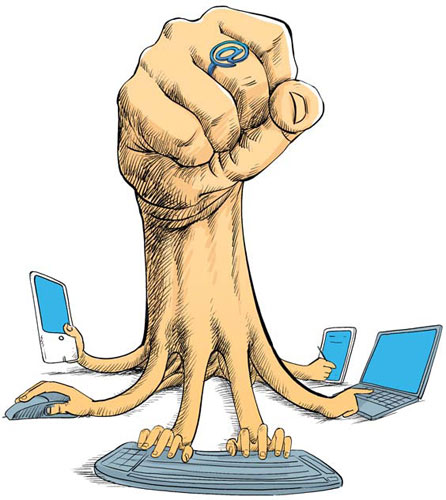Tapping into micro blogs is the new Marketing 101
Updated: 2011-04-22 09:49
By Mike Bastin (China Daily European Weekly)
Brand marketing, traditionally dominated by mass media advertising, sponsorship and celebrity endorsement, is experiencing nothing short of a revolution with the explosive emergence of social media marketing, particularly micro-blogging.
Nowhere has this phenomenon been more acutely experienced than in China, where micro-blogging has become wildly popular with some 65 million China-based micro blog accounts registered by the end of 2010. That number is growing by more than 10 million each month, according to the China Internet Network Information Center.
To fully appreciate this revolution, it is worth considering just how quickly this meteoric surge in China has taken effect. In 2009, only 155 million people in China were accessing social networks at least once a month. Today that number is 265 million, and by 2015, 488 million Internet users in China will access a social network at least once per month.
As micro-blogging becomes increasingly popular in China, more companies are taking advantage of the service to broaden their business network and build their brand. On company micro blog pages, visitors can view advertisements and see consumer feedback and even commentaries on hot social issues.
A micro blog differs from a traditional blog in that its content is typically smaller in both actual and aggregate file size. Micro blogs allow users to exchange small elements of content such as short sentences, individual images or video links.
As a result, micro-blogging is no longer simply a platform for self-expression, gossip and networking, as it is becoming an increasingly fierce battlefield for businesses wanting to promote their products and services.
China's most popular micro-blogging providers include Sina Weibo, Tencent RenRen and Kaixin001. While all of these were entertainment-oriented at first, micro-blogging services are increasingly becoming a platform for market research, marketing communication and public relations with a sharp growth in the number of social media marketers. Recent studies show that this specific group of marketers is much more active than the general user population, with 15 percent following more than 2,000 people. This is in sharp contrast to only 0.29 percent of overall users who follow more than 2,000 people.
Despite the media revolution, particularly in China, does micro-blogging really present great benefits to companies trying to build their brands? Or are there limitations that need to be understood? Will micro-blogging become a dominant element in brand-building communication campaigns? The following serves as a brief guide to any brand manager:
Possible benefits
Consumer-Brand relationship-building: Micro blogs not only provide a vehicle for marketing communication, companies can also quickly grasp the attention of current and potential consumers and interact with them on a regular basis, which could lead to an increasingly intimate relationship between consumer and brand.
Active consumer state-of-mind: Mass media brand communication remains not only prohibitively expensive for most companies but also involves an experience during which consumer state-of-mind is far more passive than active. As a result, attention to and absorption of any brand communication is often limited whereas the social networking experience necessitates a far more active, conscious mindset.
Target market "hit": As more and more micro-blogging sites emerge in China, we will probably witness some sort of specialization among competitors in order for them to sustain competitive advantage. This should result in more precisely defined demographic audiences for each of the major sites, which in turn will enable brand managers to select those that overlap most with their brand's target market. Mass media fragmentation has led to increased difficulty in "hitting" sufficient target market numbers thereby adding to the already high cost and limited effectiveness.
Repeat exposure: Social networking comments and discussions remain on the Web permanently, which may also result in a multitude of consumer exposures to any brand information, while traditional mass media requires repeat scheduling and fees.
High reach: Social networking exposure not only reaches huge numbers, it also offers greater potential for informal spreading of information unlike traditional, mass media communication. What is much more of a social experience may well lead to further discussion long after any site visit.
Brand managers, however, should not become too carried away with the benefits I've listed. The following should also be studied carefully:
Possible drawbacks
Emotional communication limited: Micro-blogging undoubtedly has a key role to play in any brand communications mix, however it will probably never offer the creative scope enjoyed by TV nor the brand association often gained via sponsorship. Picture color, content, quality and above all movement are just a few of these limitations. Sustainable competitive advantage necessitates greater emotional brand positioning, thereby exaggerating this limitation further.
Lack of credibility: While micro-blogging most definitely is seen as a more personal and possibly less biased form of commercial communication, this may well also contribute to a professional image problem. It may well be regarded, especially among image-conscious Chinese consumers, as too local and therefore basic. Furthermore, brand communication in China very often involves some sort of celebrity brand endorsement to gain credibility.
Limited technical or detailed brand information: In spite of a more active audience mindset in social networking, micro-blogging does not allow brand managers, nor consumers, to easily absorb and discuss lengthy, detailed brand issues.
Lack of face-to-face communication/observation: Micro-blogging may well result in a more personal consumer experience, but with no actual face-to-face communication, it will always lack the benefits gained from personal selling and customer in-store service.
Micro-blogging most definitely enables brand managers to listen to customer conversations, define and meet customer needs, and plan for the future in order to best meet those needs. This is the defining contribution of micro-blogging to brand-building. In terms of brand communication, however, it should be seen as a useful, low-cost form of support media, providing short, sharp brand information.
The author is visiting professor of brand management at the China Agricultural University and also teaches marketing and management at Tsinghua University.

E-paper

Han me downs
Traditional 3,000-year-old clothes are making a comeback.
Preview of the coming issue
Reaching out
Fast growth fuels rise in super rich
Specials

25 years after Chernobyl
Belarus, Ukraine and Russia will mark the 25th anniversary of the nuclear reactor explosion in Chernobyl.

Luxury car show
The world's most prestigious luxury, sports cars and supercars are displayed in Monaco.

Peking Opera revival
Traditional opera is enjoying a revival in Beijing thanks to some modern touches.
